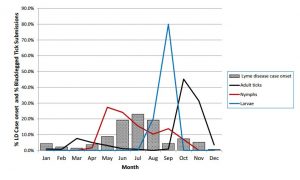Ticks go through 2 active feeding seasons in their lifetime: in the Spring when baby ticks (nymphs) are feeding to support their growth into adults; and in the fall when larvae are feeding for their molt into the nymph form, and adults are feeding to support the creation of their eggs. These times of extra activity are known as the Spring and Fall Tick Blooms. In the chart below, you can see that new cases of Lyme disease are identified most often in the time just after these blooms. 
However, feeding does not stop outside of these times. Ticks will engage in “questing” behaviour, where they climb up a piece of vegetation and look for any warm-blooded animal going by, any time the temperature is above 4 degrees Celsius.  And it does not have to be 4 degrees everywhere, just in the microenvironment the tick is in. Ticks have been found on barn cats when the outdoor temperature is minus 20 – it is thought that the cats pick up the ticks in the warmer environment in the barn.
And it does not have to be 4 degrees everywhere, just in the microenvironment the tick is in. Ticks have been found on barn cats when the outdoor temperature is minus 20 – it is thought that the cats pick up the ticks in the warmer environment in the barn.
This means that using a fast-kill tick preventive (such as Nexgard or Bravecto), and searching your pet for ticks to remove (see how here), should be regular events for your dog.
